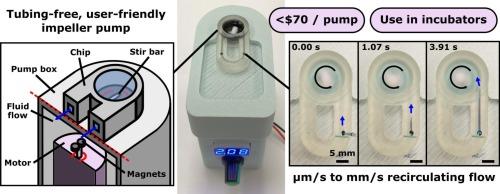开源无管叶轮泵平台,用于微流体和芯片上器官的受控再循环流体流动
IF 2.1
Q3 ENGINEERING, ELECTRICAL & ELECTRONIC
引用次数: 0
摘要
流体流动在许多微尺度技术中都有应用,包括微流体化学反应器、诊断和器官芯片(ooc)。特别是,OOCs可能依赖流体流动来输送营养物质、细胞通讯和施加剪切应力。为了使微流量系统易于被非专家采用,无管,用户友好的泵将是有用的,特别是使用简单,价格合理,并与细胞培养孵化器兼容的泵。为了满足这些需求,我们在这里分享了叶轮泵平台的设计和制造,该平台可以在不需要管道连接的情况下通过微流体回路提供再循环流体流动。流动是通过旋转泵井中的磁性搅拌棒或3d打印叶轮来驱动的,使用安装在直流电机上的磁铁。在一个紧凑的系统中使用的直流电机产生可忽略不计的热量输出,使其与细胞培养孵化器兼容。泵平台可容纳用户定义的微流体或OOC设备几何形状,可以通过3D打印轻松定制。此外,该系统很容易由低成本的材料和简单的电路组装而成,无需事先培训。我们展示了该平台在微流控设备中驱动再循环流体流动的能力,其特征流速范围从µm/s到mm/s,用于微流控技术。虽然在设计时考虑到了ooc,但我们设想该平台将使来自不同学科的用户能够将流体流动融入定制的微尺度技术中。本文章由计算机程序翻译,如有差异,请以英文原文为准。

Open-source tubing-free impeller pump platform for controlled recirculating fluid flow for microfluidics and organs-on-chip
Fluid flow is utilized in many microscale technologies, including microfluidic chemical reactors, diagnostics, and organs-on-chip (OOCs). In particular, OOCs may rely on fluid flow for nutrient delivery, cellular communication, and application of shear stress. In order for microscale flow systems to be readily adopted by non-experts, a tubing-free, user-friendly pump would be useful, particularly one that is simple to use, affordable, and compatible with cell culture incubators. To address these needs, here we share the design and fabrication of an impeller pump platform that provides recirculating fluid flow through a microfluidic loop without the need for tubing connections. Flow is driven by rotating a magnetic stir bar or 3D-printed impeller in a pump well, using magnets mounted on a DC motor. The DC motors used produce negligible heat output in a compact system, making it compatible with cell culture incubators. The pump platform accommodates user-defined microfluidic or OOC device geometries, which may be easily customized by 3D printing. Furthermore, the system is easily assembled from low-cost materials and simple circuitry by someone with no prior training. We demonstrate the ability of the platform to drive recirculating fluid flow in a microfluidic device at well-characterized flow velocities ranging from µm/s to mm/s for use with microfluidic technologies. Though designed with OOCs in mind, we envision that this platform will enable users from ranging disciplines to incorporate fluid flow in customized microscale technologies.
求助全文
通过发布文献求助,成功后即可免费获取论文全文。
去求助
来源期刊

HardwareX
Engineering-Industrial and Manufacturing Engineering
CiteScore
4.10
自引率
18.20%
发文量
124
审稿时长
24 weeks
期刊介绍:
HardwareX is an open access journal established to promote free and open source designing, building and customizing of scientific infrastructure (hardware). HardwareX aims to recognize researchers for the time and effort in developing scientific infrastructure while providing end-users with sufficient information to replicate and validate the advances presented. HardwareX is open to input from all scientific, technological and medical disciplines. Scientific infrastructure will be interpreted in the broadest sense. Including hardware modifications to existing infrastructure, sensors and tools that perform measurements and other functions outside of the traditional lab setting (such as wearables, air/water quality sensors, and low cost alternatives to existing tools), and the creation of wholly new tools for either standard or novel laboratory tasks. Authors are encouraged to submit hardware developments that address all aspects of science, not only the final measurement, for example, enhancements in sample preparation and handling, user safety, and quality control. The use of distributed digital manufacturing strategies (e.g. 3-D printing) is encouraged. All designs must be submitted under an open hardware license.
 求助内容:
求助内容: 应助结果提醒方式:
应助结果提醒方式:


